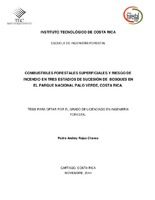Mostrar el registro sencillo del ítem
Combustibles forestales superficiales y riesgo de incendio en tres estadios de sucesión de bosques en el Parque Nacional Palo Verde, Costa Rica.
| dc.contributor.author | Rojas-Chaves, Pedro Andrey | |
| dc.date.accessioned | 2015-03-16T17:44:50Z | |
| dc.date.available | 2015-03-16T17:44:50Z | |
| dc.date.issued | 2014 | |
| dc.identifier.uri | https://hdl.handle.net/2238/4033 | |
| dc.description | Proyecto de Graduación (Licenciatura en Ingeniería Forestal) Instituto Tecnológico de Costa Rica, Escuela de Ingeniería Forestal, 2014. | es |
| dc.description.abstract | In this study, forest fuel of the standing trees and aboveground mulch was quantified. Also, the floristic composition was characterized in three successional stages of treatment, old or primary forest (38.36 ha), more than 30 years (22.75 ha) and 10-25 years (29.88 ha). The sampling design for temporary plots was a simple random and stratified, with seven replicates per treatment (15 x 50 m), with sub plots 1m2 for quantification of surface soil material. Topsoil samples were taken to the laboratory of the Center for Integration Research Forest Industry (CIIBI) at the Instituto Tecnológico de Costa Rica. The consumption tests were performed. The hazard index was determined from surface fuels. A total of 567 individuals, 57 species and 28 families (five families represented by only one individual) was identified. Only 10 species were present in the three successional stages. Most species are found in primary forest (37), while the > 30 years forest had the highest number of families (20). The primary forest has the highest amount of forestry fuel with a value of 254.67 Mg ha-1. The mature secondary forest (> 30 years) was the second highest with 196.27 Mg ha-1. The lowest values (71.31 Mg ha-1) correspond to the 10-25 years forest. The fuels accumulated in the topsoil was higher for primary forest (14.06 Mg ha-1), followed by the largest forest to 30 years (11.87 Mg ha-1), and finally the forest 10-25 years (7.75 Mg ha-1). It was found that the amount of fuel tends to be higher in the older sites. The average value obtained of IPCS was 754.32, according to the classification criteria described by Galiana (2009) and modified by Parra (2013), the three stages of succession are placed in the medium-low risk category. | es |
| dc.description.sponsorship | Instituto Tecnológico de Costa Rica, Escuela de Ingeniería Forestal. | es |
| dc.language.iso | es | es |
| dc.publisher | Instituto Tecnológico de Costa Rica | es |
| dc.rights | acceso abierto | es |
| dc.subject | Incendios forestales | es |
| dc.subject | Combustibles | es |
| dc.subject | Composición florística | es |
| dc.subject | Parcelas | es |
| dc.subject | Biomasa | es |
| dc.title | Combustibles forestales superficiales y riesgo de incendio en tres estadios de sucesión de bosques en el Parque Nacional Palo Verde, Costa Rica. | es |
| dc.type | proyecto fin de carrera | es |


